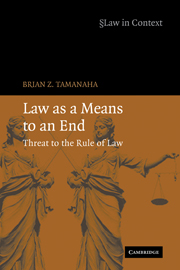Book contents
- Frontmatter
- Contents
- Acknowledgments
- Introduction
- Part 1 The spread of legal instrumentalism
- Part 2 Contemporary legal instrumentalism
- 6 Instrumentalism in legal academia in the 1970s
- 7 Instrumentalism in theories of law
- 8 Instrumentalism in the legal profession
- 9 Instrumentalism of cause litigation
- 10 Instrumentalism and the judiciary
- 11 Instrumentalism in legislation and administration
- Part 3 Corroding the rule of law
- Epilogue
- Index
- Titles in the series
11 - Instrumentalism in legislation and administration
Published online by Cambridge University Press: 25 July 2009
- Frontmatter
- Contents
- Acknowledgments
- Introduction
- Part 1 The spread of legal instrumentalism
- Part 2 Contemporary legal instrumentalism
- 6 Instrumentalism in legal academia in the 1970s
- 7 Instrumentalism in theories of law
- 8 Instrumentalism in the legal profession
- 9 Instrumentalism of cause litigation
- 10 Instrumentalism and the judiciary
- 11 Instrumentalism in legislation and administration
- Part 3 Corroding the rule of law
- Epilogue
- Index
- Titles in the series
Summary
Today there is an incalculably mammoth amount of state and federal legislation, covering virtually every conceivable subject, and an immense volume of administrative law, with more than seventy-five thousand pages of administrative rules, regulations, and proceedings published each year in the Federal Register. Administrative agencies gather knowledge and apply scientific expertise to establish regulatory schemes that effectuate legislative policies, and to monitor the achievement of legislatively established goals. Administrative law is thus a purely instrumental creature, created to carry out legislatively determined ends. Legislation, as Part 1 conveys, as been understood in consummately instrumental terms as well, for more than two centuries.
Battles over and through legislation and administrative regulations are no novelty. James Madison warned in Federalist 10 of the dangers of competing “factions,” which had already made their presence felt in the state legislatures of the day. These battles were especially heated at the outset of the twentieth century. Louis Jaffe wrote in the 1937 Harvard Law Review:
Indeed, our entire economy is honeycombed with violent and bitter intra and inter group conflict. … The power of special interests pervades our entire legal and governmental structure. … [I]t must be understood that these interests will, in one way or another, be effective, be it in the legislative or in the administrative process.
Hence, the group conflict happening today in the legislation and administrative regulatory arenas is old stuff. This is not to say, however, that what is happening today is not different in any significant respects from the past.
- Type
- Chapter
- Information
- Law as a Means to an EndThreat to the Rule of Law, pp. 190 - 212Publisher: Cambridge University PressPrint publication year: 2006

